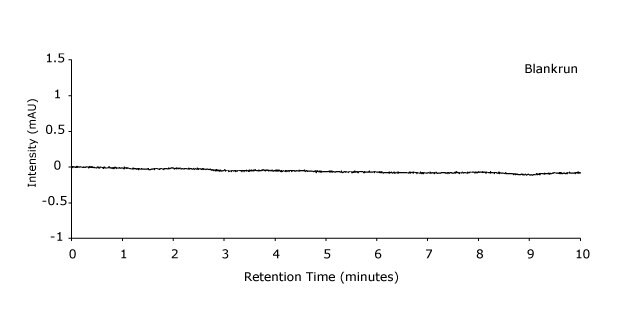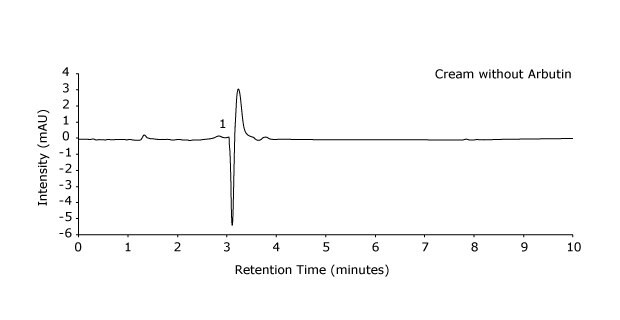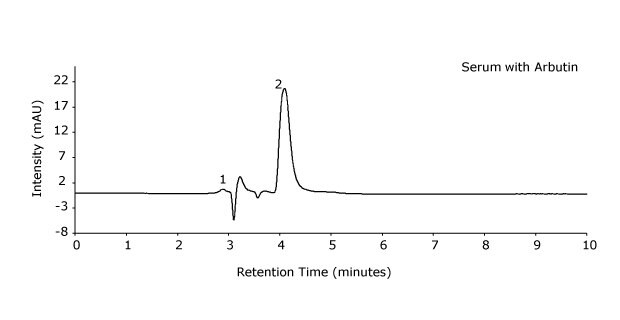Analysis of Arbutin and Hydroquinone in whitening serum using a Chromolith® HighResolution RP-18e 2 mm I.D. HPLC column
Anita Piper, R&D Chemist, Lara Celia Bergner
Introduction
Bleaching or skin whitening serums are widely used to reduce melanin content in the skin, and for such products, analytical quality control is required. Hydrochinone is a decomposition product of arbutin which can cause severe contact dermatitis in humans.
This report focuses on the testing of arbutin and hydroquinone in formulated serum products. A Chromolith® HighResolution RP-18 endcapped column 100x2mm was used on an HPLC-UV instrument, and can improve existing methods (e.g. Int. J. Appl. Sci. Eng., 2011.9.4)1.

EXPERIMENTAL CONDITIONS | |
|---|---|
Column: | Chromolith® HighResolution RP-18e, 100x2mm (1.52322) |
Detection: | Dionex Ultimate 3000 VWD-3400, UV @ 220 nm, micro flow cell (1.4 µL/7 mm) |
Mobile phase: | [A] Water, [B] methanol; isocratoc at A/B 90/10 (v/v) |
Flow Rate: | 91 µL/min |
Pressure Drop: | 22 bar (319 psi) |
Column temp.: | 25 °C |
Injection volume: | 0.5 µL |
Samples |
|
Diluent | Water/Methanol 30/70 (v/v) |
Standard solution (10 mg/mL) | Accurately weigh 5 mg of each standard into a 50 mL volumetric flask and add 40 mL diluent. Sonicate for 5 min and fill up to mark with diluent. Pipette 5 mL of this solution into a 50 ml volumetric flask and fill up to mark with diluent. Pass through a 0.45 µm syringe filter before injection. |
Sample solution | Place 1 g of homogenized serum in a 50 mL volumetric flask, add 30 mL of diluent and sonicate for 5 minutes. Fill up to volume with diluent. Transfer 3 mL of this suspension into a 25 mL volumetric flask and fill up to volume with diluent. The resulting cream sample concentration in the final dilution is 2.4 mg/mL. Pass through a 0.45 µm syringe filter before injection. |

Figure 1.Chromatogram blank.

Figure 2.Chromatogram standard solution arbutin and hydroquinone each at 10 µg/mL.
Chromatographic Data - Standard Solution (10 µg/mL ) | |||||
|---|---|---|---|---|---|
No. | Compound | Retention Time (min) | S/N | Area (mAU*min) | Tailing Factor |
1 | t0 void volume | 2.9 | |||
2 | Arbutin | 4.1 | 94.3 | 0.8407 | 1.4 |
3 | Hydroquinone | 5.1 | 368.4 | 1.6358 | 1.8 |
Specificity Test: The standard solution of arbutin and hydroquinone (each at 10 µg/mL) was injected and the retention time and content of desired analyte determined (Table 1). Repeatability was determined by 5 injections of a serum sample solution (Table 2). Calibration and sensitivity results for arbutin and hydroquinone (calibration range 0.10-15.5 µg/mL for arbutin and 0.10-15.3 µg/mL for hydroquinone with 9 calibrators) are shown in Table 3.
Compound | Retention Time (min) | Area (mAU*min) | Tailing Factor | S/N | |
|---|---|---|---|---|---|
1 | Arbutin | 4.1 | 0.8407 | 1.4 | 141.7 |
2 | Hydroquinone | 5.1 | 1.6358 | 1.8 | 488.9 |
Sample | Area (mAU*min) |
|---|---|
STD 1 | 5.2146 |
STD 2 | 5.2615 |
STD 3 | 5.2657 |
STD 4 | 5.2224 |
STD 5 | 5.3311 |
Mean | 5.2702 |
Standard Deviation | 0.0451 |
(%) RSD | 0.9 |
Compound | LOD (µg/mL) | LOQ (µg/mL) | R2 |
|---|---|---|---|
Arbutin | 2.7 | 8.2 | 0.9992 |
Hydoquinone | 0.5 | 1.4 | 0.9994 |

Figure 3.Calibration curve arbutin.

Figure 4.Calibration curve hydroquinone.

Figure 5.Chromatogram serum without arbutin.

Figure 6.Chromatogram serum containing arbutin
Chromatographic Data - Serum with Arbutin | |||||
|---|---|---|---|---|---|
No. | Compound | Retention Time (min) | S/N | Area (mAU*min) | Tailing Factor |
1 | t0 void volume | 2.9 | |||
2 | Arbutin | 4.1 | 563.5 | 4.9694 | 1.7 |
3 | Hydroquinone | n.d. |
|
|
|
Calculation
ωSample = cst/cPr
ωSample = (63.00 μg/mL) / (2.4 mg/mL)
ωSample = 26.25 µg/mg or 2.63% Arbutin in Serum
where,
ωSample = Concentration of Arbutin in the sample
cst = Concentration calculated from calibration curve (µg/mL)
cPr = Concentration of serum sample in final dilution (mg/mL)
Conclusion
It was shown, that a Chromolith® HighResolution RP-18e 100x2mm column coupled to UV detection can be utilized for the determination of arbutin and hydrochinone in serum. For arbutin, the resulting limit of detection (LOD) was 2.7 µg/mL, and the limit of quantitation (LOQ) was 8.2 µg/mL in the final dilution sample, representing limits for the serum samples of 1.13 mg/g (LOD) and 3.42 mg/g (LOQ); for hydroquinone, the results were 0.5 µg/mL (LOD) and 1.4 µg/mL (LOQ) in the final dilution sample, representing limits for the serum samples of 0.21 mg/g (LOD) and 0.58 mg/g (LOQ). Due to the excellent permeability and low backpressure of this column type, an analytical HPLC-System with a micro cell could be used.
References
To continue reading please sign in or create an account.
Don't Have An Account?